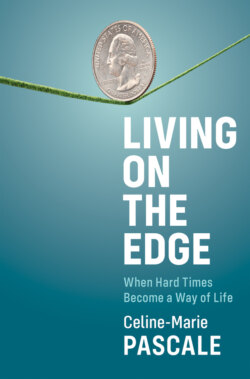Читать книгу Living on the Edge - Celine-Marie Pascale - Страница 11
The Struggling Class
ОглавлениеIt’s common to hear people use the term “working class” as if it is synonymous with low-wage, unskilled work. But it hasn’t always been that way. Well into the 1970s, the term “working class” designated a kind of labor that required various levels of skill and which was physically demanding – so much so that it often placed workers’ health and well-being at risk. The blue-collar workers who held those jobs earned a middle-income wage that paid for a mortgage, a family car, often a boat or recreational vehicle, and sometimes a vacation home. Those jobs have largely disappeared. Today’s workplace is primarily divided between two kinds of jobs: high-skill, high-wage jobs and low-skill, low-wage jobs.3 Today the term “working class” is most often used as a euphemism for poor people, many of whom work in service sector jobs.
In contrast to working-class jobs, service sector employment is largely characterized by low pay, part-time hours, no benefits and general instability.4 Some people use terms like “the poor” or “the working poor” to describe people who work full-time yet struggle financially. Honestly, I have never met working people who used these terms to describe themselves. My family wasn’t alone in calling ourselves middle class, when we couldn’t even count on having adequate food. But when I was on the road, I heard something different. When I asked people how they saw themselves in terms of class, some declined to say. They told me they just don’t think about class. Many others described themselves as belonging to “the struggling class.” Two things about this term are really important to me: First, this isn’t a label or an understanding imposed on people from the outside. This is how people talked about themselves. Second, the term “the struggling class” addresses economic hardship in ways that I consider to be profound; it encompasses the danger, the dignity and the hope that characterize the lives of people I met. They are not getting ahead, but they have not given up. They struggle. They weigh how long they can go without treating a bad tooth or if they can afford to pay for groceries if they buy shoes for their child. Despite working one or two jobs, they know that a single unexpected event could force them deeper into financial troubles from which they might never emerge. People in the struggling class live paycheck to paycheck, doing the very best they can for themselves, their children, and often their extended families. They live in the hope that one day they will find themselves on a solid economic footing – a hope they hold against all the odds.
The term “the struggling class” seems more accurate than anything I have ever heard used to describe a group of people working hard to keep their heads above water. Belonging to the struggling class isn’t a single kind of experience. There are individual differences, of course, but more importantly class experience varies by race, gender and region. These differences will become apparent by the kinds of experiences people do or don’t encounter. No one featured in this book was asked to speak for anyone but themselves. Yet it is my hope that their voices will help to change how the nation thinks about the struggling class. It is impossible to fully understand the experiences of the struggling class without understanding some of the concepts that are used to identify economic hardship. The concepts may seem a bit technical, but they will help to bring some insight into things that generally don’t make sense: a booming economy that leaves most families living paycheck to paycheck, families who can’t afford basic living expenses but don’t qualify as poor enough for assistance, and the way politicians talk about folks being left behind. The rest of this chapter lays out three key frameworks that are often used when people talk about the economy: work, housing, and poverty.
